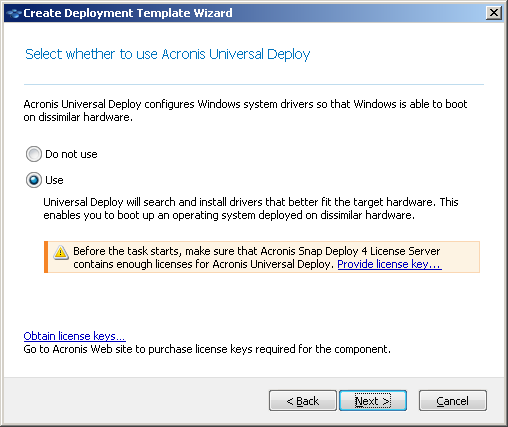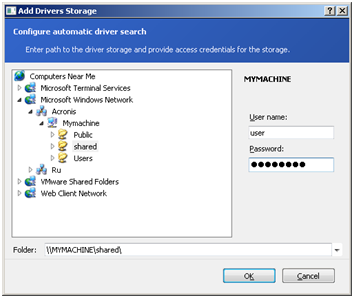Acronis Universal Deploy will help you to create a bootable Windows clone on different hardware by automatically installing the necessary system drivers. Use Acronis Universal Deploy when deploying Windows to a machine with a dissimilar processor, different motherboard or other mass-storage device than in the imaged system. For detailed information, see “What is Acronis Universal Deploy”.

Select whether to use Acronis Universal Deploy
Acronis Universal Deploy uses three sources for drivers:
- The Windows default driver storage folder (in the master image being deployed)
- The driver repository, which is one or more network folders or removable media
- The mass-storage device driver specified by the user
The software will find the most suitable drivers of all available drivers and install them into the deployed system. However, the driver defined by the user will have the priority. It will be installed, with appropriate warnings, even if the software finds a better driver.
Specify a driver storage to search for HAL and storage device drivers during the automatic search-and-install procedure. You can add network locations and enable a search of removable media for drivers.

Adding a driver storage
If the target hardware has a specific mass-storage controller (such as a SCSI, RAID, or Fibre Channel adapter) for the hard disk, explicitly specify the appropriate driver for that controller. The driver will be installed in any case, bypassing the automatic driver search-and-install procedure.
Use this option only if the automatic search-and-install procedure was unsuccessful.
Tip: When deploying the system to a virtual machine that uses SCSI hard drive controller, make sure to specify SCSI drivers for the virtual environment. For example, VMware requires Buslogic or LSI logic drivers. Use drivers bundled with your virtualization software or download the latest driver versions from the software manufacturer’s Web site.